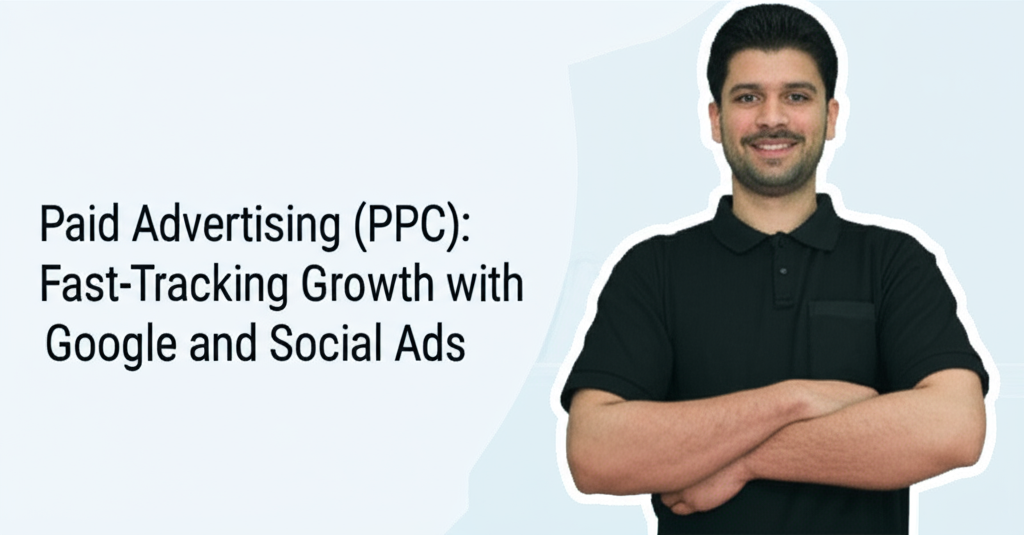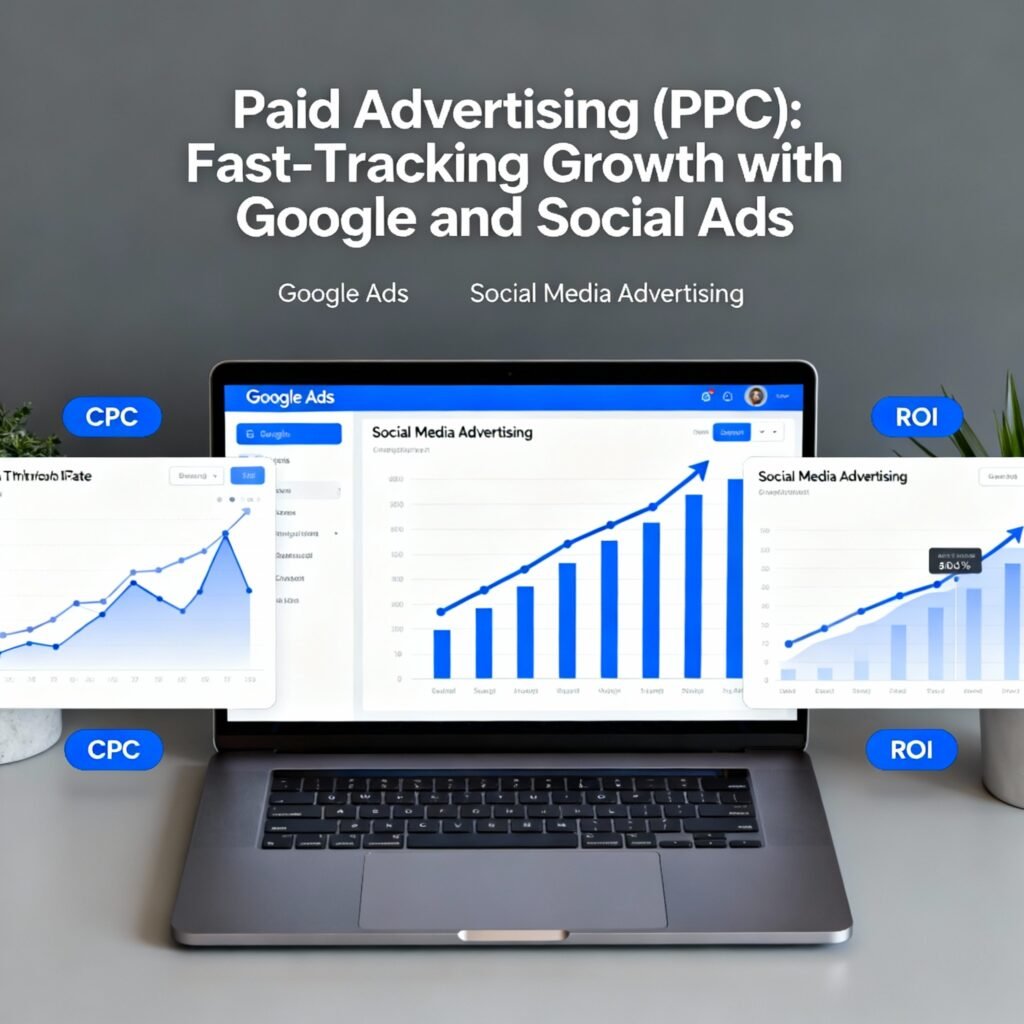
Paid Advertising (PPC) is the accelerator pedal for your business. While SEO and organic social media build long-term authority, a well-executed PPC campaign delivers immediate, targeted traffic and leads directly to your doorstep. This post will guide you through launching smart, data-driven ad campaigns that generate a real return on investment.
Table of Contents
- Beyond Organic: The Strategic Role of Paid Advertising
- Laying the Groundwork: Goals, Budget, and Tracking
- The Google Ads Ecosystem: Capturing Intent
- The Social Ads Ecosystem: Stimulating Demand
- The Anatomy of a High-Converting Ad
- Launch, Analyze, and Optimize: The Cycle of Improvement
- Conclusion: Integrating Paid Ads into Your Marketing Symphony
1. Beyond Organic: The Strategic Role of Paid Advertising
Our previous posts have armed you with strategies to build a powerful organic foundation: SEO for lasting visibility, content for authority, community for engagement, and email for conversion. But what if you need results now? What if you want to scale beyond the natural pace of organic growth?Paid Advertising (PPC)
Enter Paid Advertising, or Pay-Per-Click (PPC). PPC is the accelerator pedal for your business. It allows you to:
- Generate Immediate Traffic and Leads: Bypass the months-long wait for SEO rankings and get in front of your ideal audience today.
- Target with Surgical Precision: Reach people based on their demographics, interests, online behavior, and—critically—their search queries.
- Test and Validate Rapidly: Quickly A/B test new messaging, offers, and even products with real-world data.
- Control Costs: You only pay when someone clicks on your ad, giving you direct control over your advertising spend.
Think of organic marketing as a marathon—building long-term, sustainable value. Think of paid advertising as a sprint—achieving specific, short-term growth goals. The most successful businesses run both.
2. Laying the Groundwork: Goals, Budget, and Tracking
Jumping into ads without a plan is a fast way to burn cash. A successful campaign starts long before you write your first headline.
Defining Your Campaign Objective
Every ad campaign must begin with a clear goal. Are you trying to:
- Build Awareness? (Branded video views, reach)
- Generate Leads? (Newsletter signups, content downloads)
- Drive Sales? (Online purchases, store visits)
Your objective will dictate your platform choice, ad format, and how you measure success.
Setting a Smart Budget and Bidding Strategy
- Budget: Start small. A daily budget of $20-$50 is enough to gather valuable data without significant risk. You can scale what works.
- Bidding: Platforms use automated bidding strategies aligned with your goal (e.g., “Maximize Clicks” for traffic, “Target Cost Per Acquisition” for leads). Starting with a platform-recommended strategy is often best for beginners.
The Non-Negotiable: Conversion Tracking
This is the most critical step. If you can’t measure it, you can’t improve it. You must install a pixel (Meta) or tag (Google) on your website to track actions like purchases, sign-ups, or form submissions. This tells the platform what a “win” looks like, allowing its algorithm to optimize your ads to find more people likely to convert.
3. The Google Ads Ecosystem: Capturing Intent
Google ads are powerful because they target user intent—people actively searching for solutions.
Search Ads: Answering User Queries
These are the text ads that appear at the top of Google search results.
- How it works: You bid on keywords (e.g., “best running shoes for flat feet”). When someone searches that term, your ad may appear.
- Best for: Users late in the buying cycle. They know what they want and are ready to take action.
- Key to success: Keyword research (from Post 2) and aligning your ad copy perfectly with the search query.
Performance Max: Automated, Cross-Channel Reach
This is a powerful, goal-based campaign type that automated ad placement across all of Google’s networks—Search, YouTube, Gmail, Discover, and the Display Network.
- How it works: You provide assets (headlines, images, videos, logos) and a budget. Google’s AI automatically tests and shows the best combination to drive your specified conversion across its properties.
- Best for: Driving conversions across the entire customer journey, especially when you have strong conversion data already.
- Key to success: Feeding the algorithm with high-quality creative assets and a well-defined audience signal.
YouTube Ads: Building Awareness and Consideration
Video is unparalleled for storytelling and building trust.
- Ad Formats: Skippable in-stream ads (play before other videos), non-skippable ads, and discovery ads (appear in YouTube search results).
- Best for: Top-of-funnel awareness campaigns, product demonstrations, and building brand affinity.
- Key to success: Capturing attention in the first 5 seconds and creating valuable, engaging content.
4. The Social Ads Ecosystem: Stimulating Demand
Social ads excel at interrupting users with relevant offers they didn’t know they wanted, based on their interests and demographics.
Meta Ads (Facebook & Instagram): Unmatched Targeting
Meta’s strength is its incredibly detailed user data, allowing for hyper-specific audience targeting.
- Audience Types:
- Core Audiences: Target by age, location, interests, and behaviors.
- Custom Audiences: Retarget people who have already visited your website or are on your email list (incredibly powerful).
- Lookalike Audiences: Find new people who share characteristics with your best existing customers.
- Ad Formats: Feed ads, Stories ads, Carousel ads, and more. Perfect for visually appealing products and brands.
- Best for: Brand building, lead generation, and e-commerce sales.
LinkedIn Ads: Reaching Professional Audiences
The premier platform for B2B marketing.
- How it works: Target users by job title, company, industry, seniority, and skills.
- Ad Formats: Sponsored Content, Message Ads (InMail), and Text Ads.
- Best for: B2B lead generation, recruiting, and promoting whitepapers or webinars to a professional audience.
- Key to success: A professional tone and a clear value proposition for the user’s business role.
5. The Anatomy of a High-Converting Ad
Great targeting is wasted on a poor ad.
Crafting Compelling Ad Copy
- Headline: Grab attention and include a primary keyword or benefit.
- Body Text: Clearly state the offer and the value proposition. What’s in it for them? Use social proof if possible.
- Call-to-Action (CTA): Use a strong, action-oriented button: “Shop Now,” “Learn More,” “Download,” “Sign Up.”
Using Visuals That Stop the Scroll
- High-Quality Imagery/Video: Use bright, clear, and professional visuals.
- Relevance: The visual must directly relate to the copy and offer.
- Minimal Text: Especially on Facebook/Instagram, avoid images cluttered with text.
The Landing Page: Where the Conversion Happens
Your ad’s job is to get the click. The landing page’s job is to get the conversion. They must be perfectly aligned.
- Consistency: The headline, imagery, and offer on the landing page must match the ad exactly.
- Clarity: One primary goal per page. Remove all navigational links that could distract the user.
- Simple Form: Only ask for essential information. The fewer the fields, the higher the conversion rate.
6. Launch, Analyze, and Optimize: The Cycle of Improvement
A campaign is not a “set it and forget it” tool. It requires ongoing management.
- Let it Learn: After launch, give the algorithm 3-7 days to gather data before making judgments.
- Analyze Key Metrics:
- Click-Through Rate (CTR): How enticing is your ad?
- Cost Per Click (CPC): How much are you paying for traffic?
- Conversion Rate (CVR) & Cost Per Acquisition (CPA): How efficient are you at achieving your goal?
- Optimize: Double down on high-performing ads, audiences, and keywords. Pause underperformers. Continuously test new variations.

7. Conclusion: Integrating Paid Ads into Your Marketing Symphony
Paid advertising is not a standalone tactic. It is the powerful soloist that plays its part within your entire marketing orchestra.
Paid Advertising (PPC) offers an unmatched ability to drive targeted growth quickly. By focusing on strategic targeting, compelling creatives, and data-driven optimization, you can transform your ad spend into your most powerful customer acquisition channel.
Use PPC to:
- Jumpstart SEO: Bid on keywords you’re trying to rank for organically to gather data and generate immediate traffic.
- Amplify Content: Boost a high-performing blog post or video to a targeted audience.
- Grow Your Community: Run ads promoting your Facebook Group or newsletter sign-up.
- Retarget Engaged Users: Use website retargeting ads to bring back visitors who didn’t convert, offering them a new incentive.
You have now completed the journey through the core pillars of digital marketing: SEO, Content, Community, Email, and Paid Ads. Each is powerful on its own, but together, they form an interconnected ecosystem for sustainable, scalable growth. You are now equipped to attract, engage, and convert your audience through every stage of their journey. Go forth and grow